Introduction to Social Selling

What is Social Selling
Social selling is a strategic approach to leveraging social media platforms to connect with prospects, build relationships, and ultimately drive sales. It involves using platforms like LinkedIn, Facebook, Twitter, and Instagram to establish a professional brand, engage with target audiences, and foster meaningful interactions that can lead to sales opportunities.
Social selling lies in its ability to enable sales professionals to tap into existing networks, identify potential customers, and nurture relationships without traditional sales pitches.
By sharing relevant content, responding to queries, and participating in discussions, salespeople position themselves as industry thought leaders and trusted advisors.
Why is Social Selling Effective
Social selling is highly effective because it aligns with the modern buyer’s journey, which increasingly begins and progresses online.
In an environment where buyers are self-educating through social media and content, social selling helps sales professionals to connect and engage with prospects right where they are most active.
Key Reasons for Social Selling Effectiveness:
Increased Reach and Visibility
- Social platforms enable sales professionals to reach a larger audience than traditional methods.
- According to LinkedIn, 78% of social sellers outsell peers who don’t use social media.
Enhanced Trust and Relationship Building
- Regular interaction on social media helps establish credibility and trust.
- A Salesforce study found that 62% of buyers search for professional recommendations on social platforms before proceeding with a purchase.
Insight into Prospective Buyers
- Social selling tools like LinkedIn Sales Navigator allow sales teams to tailor their approach by providing detailed insights into the needs and behaviors of potential buyers.
- These tools make it possible to track engagement, helping sales reps understand what content works best.
Personalized Outreach
- Social media enables salespeople to personalize their communication based on the information available on prospect profiles.
- Personalized messages can increase response rates by up to 50%, according to HubSpot.
Continuous Lead Generation
- By engaging with content, commenting, and sharing insights, sales professionals continually expose their network to their expertise, subtly generating leads.
- Social media presence can enhance lead generation efforts, as 45% of marketers have gained customers through LinkedIn (HubSpot).
Strategic Content Sharing:
- Sharing relevant content that resonates with the target audience positions salespeople as thought leaders.
- Informative and insightful posts contribute to high-quality engagements, driving further interest and conversions.
Quicker Sales Conversions:
- The rapport built through consistent social engagement can shorten the sales cycle.
- According to IBM, social selling can increase sales performance by over 400% compared to cold calling.
How is Social Selling Different from Traditional Selling
Which Social Media Platforms is Best for Your Social Selling Strategy

Choosing the right social media platform for your social selling strategy depends heavily on where your target audience spends their time and the nature of your products or services.
Each platform offers unique features and benefits tailored to different types of business interactions.
Best social selling platform for B2B Sales: LinkedIn is the top platform for B2B marketers, with over 700 million professionals using the platform. It's ideal for connecting with industry leaders, decision-makers, and professionals.
- Features: LinkedIn Sales Navigator, advanced search filters, and InMail allow for targeted and personalized outreach.
- Effectiveness: According to LinkedIn, 80% of B2B leads from social media come through LinkedIn.
Wide Audience Reach: Facebook has over 2.8 billion monthly active users, offering the largest base to reach diverse demographics.
- Features: Facebook Pages, groups, and targeted ads can effectively engage potential customers.
- Engagement: Businesses see an average engagement rate of 0.08% across all industries, which can be significant given the vast user base.
X ( Previously Known as Twitter)
Real-Time Interaction: Ideal for brands looking to engage in real-time and leverage trends quickly.
- Features: Twitter’s hashtag system, retweets, and direct messaging facilitate instant communication and broad visibility.
- Usage: Over 500 million tweets are sent each day, providing a vast pool of content and engagement opportunities.
Visual Engagement: Best suited for brands with strong visual content that can capture attention quickly.
- Features: Instagram Stories, posts, and IGTV provide rich formats for showcasing products and storytelling.
- Growth: With over 1 billion monthly users, Instagram’s user base is highly engaged, making it a hotspot for consumer brands.
Choosing the Right Platform
- Identify Your Audience: Determine which platform your target customers use most frequently.
- Align with Content Strengths: Choose a platform that best supports the type of content you create (e.g., visuals, long-form posts, quick updates).
- Consider Your Sales Cycle: Platforms like LinkedIn are more conducive to longer B2B sales cycles, while Instagram and Facebook can quickly drive B2C transactions.
Steps to Social Selling on Linkedin
LinkedIn is the premier platform for B2B marketing and social selling due to its professional user base and networking-focused features. Here’s how to leverage LinkedIn for effective social selling:
Optimize Your Profile:
- Ensure your profile is professional, with a clear photo and a headline that communicates your expertise.
- Highlight your successes in your summary and experience sections to establish credibility.
Build and Expand Your Network:
- Connect with industry peers, potential clients, and thought leaders.
- Regularly engage with their content to maintain visibility and foster relationships.
Share Valuable Content:
- Post articles, insights, and industry news that add value to your connections.
- According to LinkedIn, users who share content weekly are nearly 10x more likely to have meaningful conversations on the platform.
Use Advanced Tools:
- LinkedIn Sales Navigator can help you target the right people with advanced search capabilities.
- Track engagement and measure the effectiveness of your social selling efforts through analytics.
Engage in Meaningful Conversations:
- Respond to comments on your posts and reach out with personalized messages.
Steps to Social Selling on Facebook
Facebook offers a vast audience and tools suitable for both B2C and B2B interactions, making it a versatile platform for social selling.
Create a Professional Business Page:
- Set up a Facebook Business Page with all essential information about your business.
- Regularly update your page with contact information, services, and products.
Utilize Facebook Groups:
- Join relevant groups where your target customers are active, or start your own.
- Engage actively by answering questions and offering solutions that demonstrate your expertise.
Leverage Facebook Ads:
- Use Facebook’s advanced targeting options to reach specific demographics.
- Retargeting ads can increase engagement by showing your ads to users who have visited your page or website.
Post Regularly:
- Share updates, blog posts, and customer testimonials to keep your audience engaged.
- Videos and live broadcasts on Facebook have shown to significantly increase engagement, with live videos receiving six times the interactions of non-live ones.
Monitor and Respond:
- Keep track of comments and messages to respond promptly.
- Utilize Facebook Messenger for real-time communication with prospects, which can help personalize interactions and build stronger relationships.
Steps to Social Selling on X ( Previously Known as Twitter)
Twitter is a dynamic platform that allows for real-time engagement and can be a potent tool for social selling, particularly in industries that value up-to-the-minute news and direct communication.
Optimize Your Profile:
- Ensure your profile clearly states your professional expertise with a professional photo and a concise bio.
- Include a link to your company website or a landing page that offers more information about your services.
Grow and Engage Your Network:
- Follow relevant accounts, including industry leaders, potential clients, and peers.
- Use Twitter lists to organize your feeds and stay focused on engaging with key individuals and topics.
Share and Curate Content:
- Tweet regularly with a mix of original content and curated resources that are valuable to your audience.
- Retweets and mentions can amplify your presence and show engagement with the community.
Participate in Twitter Chats:
- Join or host Twitter chats to engage in real-time discussions on topics relevant to your industry.
- This boosts visibility and positions you as an active participant in your field.
Leverage Twitter Ads:
- Use targeted ads to reach a broader audience or promote specific products and campaigns.
- Promoted tweets can increase your reach and drive more specific actions like clicks to your website.
Monitor Interactions and Analytics:
- Use Twitter’s analytics tools to track engagement and tweak your strategy based on what content performs best.
- Respond quickly to tweets and mentions to keep conversations going and build relationships.
Steps to Social Selling on Instagram
Instagram is highly visual and influential, making it an excellent platform for brands looking to engage younger demographics or showcase products that benefit from visual representation.
Optimize Your Profile:
- Create a compelling Instagram bio that describes your business and includes a call-to-action.
- Use a business account to get access to advanced features like Instagram Insights and Ads.
Use High-Quality Visual Content:
- Post high-resolution photos and videos to capture attention.
- Consistent aesthetic themes can help your brand become more recognizable and appealing.
Engage With Stories and Reels:
- Use Instagram Stories and Reels for more casual, behind-the-scenes looks or quick showcases of products.
- Interactive elements like polls, questions, and swipe-up links can drive engagement and traffic to your site.
Incorporate Hashtags Strategically:
- Use relevant hashtags to reach a broader audience beyond your followers.
- Research and use hashtags that are popular within your industry but not so broad that your posts get lost.
Run Targeted Ad Campaigns:
- Utilize Instagram’s powerful targeting tools to deliver ads to precisely the right audience.
- Well-crafted ads on Instagram can see engagement rates of over 1%, higher than many other platforms.
Collaborate with Influencers:
- Partner with influencers who align with your brand to extend your reach and credibility.
- Influencer collaborations can lead to direct increases in followers and potential customer engagement.
10 Effective Strategies for Selling on Social Media

Selling on social media can be highly effective if done correctly, as it combines the broad reach of social networks with targeted marketing tactics. Here are 10 effective strategies for selling on social media, explained in depth:
1. Leverage User-Generated Content (UGC)
User-generated content such as reviews, testimonials, and photos shared by users, serves as social proof, building trust and authenticity around your brand. When potential customers see real people endorsing your product, it increases credibility and influences their buying decisions.
How to Implement:
- Encourage Sharing: Create incentives for customers to share their experiences with your products. This can be through contests, hashtags, or discounts for posts featuring your product.
- Feature UGC: Regularly share user-generated content on your own social media channels. Highlighting customer stories or reviews can make your brand feel more relatable.
- Collaborate with Users: Engage with users who frequently post about your products to co-create content. Their enthusiasm can be contagious and spread to a wider audience.
2. Use Targeted Advertising
Social media platforms offer powerful targeting tools that allow you to reach a specific audience based on demographics, interests, behaviors, and more. This precision helps in directing your marketing efforts to the right people, increasing conversion rates.
How to Implement:
- Define Your Audience: Use the data available on social platforms to identify the characteristics of your ideal customer. This can include age, location, interests, and even purchasing behavior.
- Create Tailored Ads: Design different ads for different segments of your audience to address their specific needs and desires. Personalization can significantly improve engagement.
- Test and Optimize: Run multiple versions of ads to see what works best. Use A/B testing and adjust your strategy based on performance metrics like click-through rates and conversion rates.
3. Engage with Your Audience Actively
Engagement builds relationships and fosters loyalty. Responding to comments, messages, and posts quickly can show that your brand values its customers, which can encourage repeat business and referrals.
How to Implement:
- Prompt Responses: Use tools like chatbots for immediate responses and have a team ready to handle more complex queries or feedback.
- Community Building: Host live sessions, Q&A’s, and discussion forums where you can interact directly with your audience, answer their questions in real time, and get to know them better.
- Content Interaction: Create interactive content such as polls, surveys, and contests to keep your audience engaged and interested in your brand.
4. Offer Exclusive Deals and Promotions
Exclusive deals on social media can drive sales by creating a sense of urgency and exclusivity. Limited-time offers or social-media-only promotions encourage users to take quick action to capitalize on the deal.
How to Implement:
- Time-Sensitive Discounts: Launch flash sales or time-bound discounts that compel users to act quickly.
- Social Media Codes: Offer promo codes that users can redeem on your website, exclusive to your social media followers.
- Early Access: Provide early access to new products or special events to your social media audience to make them feel valued.
5. Utilize Influencer Partnerships
Influencers can amplify your brand’s message to a larger and often more engaged audience. Their endorsement serves as a powerful form of social proof, potentially driving significant traffic and sales.
How to Implement:
- Choose the Right Influencers: Partner with influencers who align with your brand values and have an audience that matches your target demographic.
- Collaborate on Content: Work closely with influencers to create content that feels authentic and true to both their style and your brand.
- Track Performance: Use unique tracking codes or affiliate links to measure the impact of influencer campaigns on your sales and adjust your strategy based on these insights.
6. Optimize Content for Each Platform
Different social media platforms cater to different audiences and content formats. Tailoring your content to fit the platform can increase its appeal and effectiveness.
How to Implement:
- Understand Platform Dynamics: Each platform has its unique characteristics (e.g., Instagram favors high-quality visuals, Twitter is great for quick updates, LinkedIn is ideal for B2B content).
- Adapt Content Accordingly: Create and adapt content that resonates best with the audience on each platform. For instance, use eye-catching images and videos on Instagram, timely and engaging posts on Twitter, and detailed articles or company news on LinkedIn.
- Use Platform-Specific Features: Take advantage of specific features like Instagram Stories, Facebook Live, or Twitter Polls to engage users and increase visibility.
7. Implement Social Listening
Social listening allows you to monitor conversations about your brand, competitors, and industry online. This can help you understand consumer behavior, identify trends, and adjust your strategies accordingly.
How to Implement:
- Monitor Mentions: Use social listening tools to track mentions of your brand, products, and competitors across social networks.
- Engage with Conversations: Actively participate in conversations where your brand is mentioned. Respond to feedback, thank potential customers, and resolve issues promptly.
- Analyze Insights: Gather insights from the data collected through social listening to better understand customer needs and improve your products and services.
8. Create a Seamless Shopping Experience
Streamlining the path from discovery to purchase reduces friction and can significantly enhance conversion rates. Integrating shopping features directly into social media platforms makes it easier for users to buy without leaving the app.
How to Implement:
- Use Social Commerce Tools: Platforms like Instagram and Facebook allow you to create shoppable posts and stores. Utilize these features to let users shop directly from your social media profiles.
- Optimize for Mobile: Ensure that the shopping experience is mobile-friendly, as a significant portion of social media browsing is done on mobile devices.
- Simplify Checkout: Reduce the number of steps required to make a purchase, and offer various payment options to accommodate different preferences.
9. Regularly Update Content with Trends
Keeping up with trends keeps your content relevant and engaging, which can attract more followers and potential customers. It shows that your brand is current and understands popular culture or industry shifts.
How to Implement:
- Monitor Trends: Stay updated with the latest trends in your industry and on social media platforms. Use tools like Google Trends and social media trend reports.
- Quick Adaptation: Develop a flexible content strategy that allows you to quickly incorporate trending topics or memes into your posts.
- Balance Trends and Brand Identity: While it’s important to stay trendy, ensure that all content still aligns with your brand’s voice and message.
10. Focus on Video Content
Video is one of the most engaging forms of content on social media. It can convey more information in less time and generates higher engagement than text or images alone.
How to Implement:
- Diversify Video Formats: Use a mix of video formats such as live videos, tutorials, product demos, and customer testimonials.
- Invest in Quality: Ensure that videos are high-quality and well-edited to maintain a professional image.
- Optimize for Silent Viewing: Many users watch videos without sound, especially on mobile. Include captions and make sure your videos are understandable without audio.
How to Engage With Your Buyers on Social Networks
Engaging with your buyers on social networks effectively involves a proactive approach and thoughtful communication. Here’s how you can do it:
1. Respond Promptly
Quickly respond to comments, questions, and messages. This shows that you value your customers and their time. Use social media management tools to stay on top of interactions.
2. Personalize Your Responses
Address customers by name and tailor your responses to their specific comments or queries. This personal touch can significantly enhance customer satisfaction and loyalty.
3. Ask for Feedback
Regularly seek feedback about your products and services. This not only provides you with valuable insights but also makes customers feel involved and valued.
4. Provide Value Through Content
Share content that is not just promotional but also educational or entertaining. Include tips, how-tos, and relevant news updates that keep your audience informed and engaged.
5. Host Live Sessions
Utilize live video features to host Q&A sessions, product demos, or behind-the-scenes tours. Live interactions are great for engaging directly with your audience in real time.
6. Acknowledge and Reward Engagement
Show appreciation for customer interaction by featuring their content, offering exclusive deals, or conducting giveaways. Recognizing active users can foster a more vibrant community.
7. Use Stories and Temporary Posts
Make use of ephemeral content like stories to share daily activities, special offers, or quick updates. These can be more casual and relatable, encouraging more frequent interactions.
Best Social Selling Tools You Should Use in 2024
To enhance your social selling strategy in 2024, leveraging the right tools is essential. These tools can help your sales team optimize their outreach efforts, manage relationships with existing customers, and boost your personal brand on social media networks.
Here are the best social selling tools you should consider using:
1. LinkedIn Sales Navigator
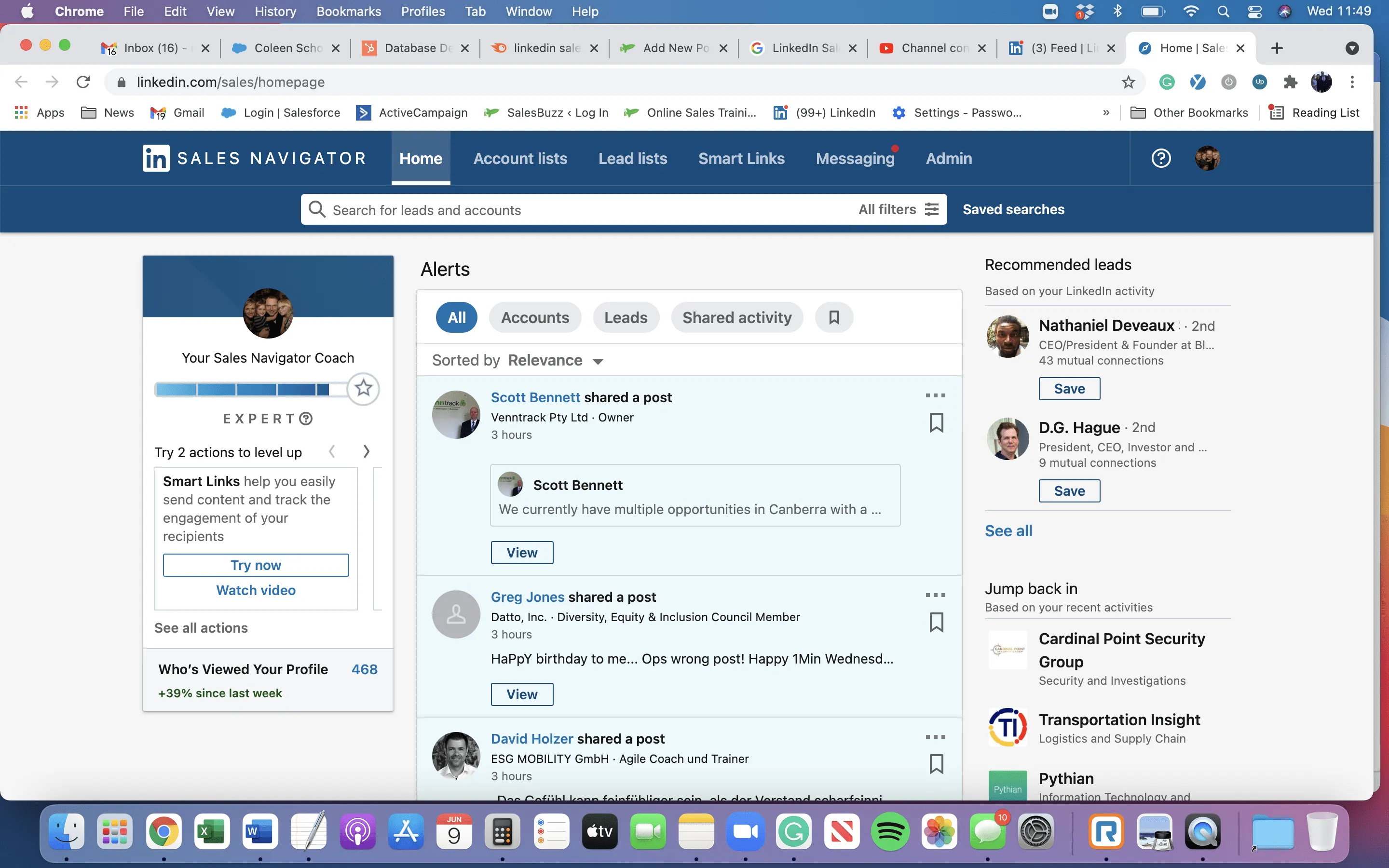
- Purpose: Tailored for sales professionals, this tool helps you tap into LinkedIn's vast network to find and connect with potential leads.
- Features: Advanced search capabilities, lead recommendations, and insights into company data.
- Benefits: It allows your sales team to personalize outreach efforts based on rich profile data and engagement metrics, making it easier to follow social selling best practices.
2. Hootsuite
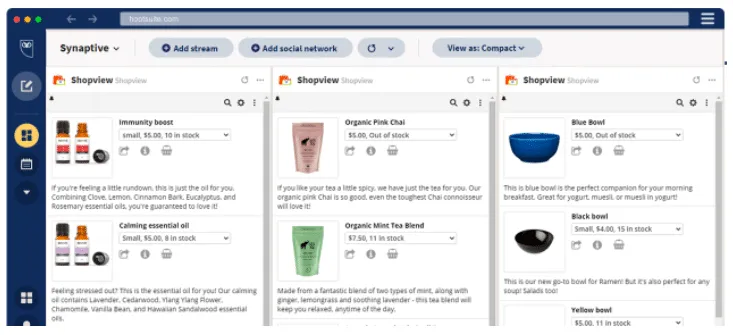
- Purpose: A comprehensive social media management platform that lets you schedule posts, monitor conversations, and track engagement across multiple social media networks.
- Features: Post scheduling, analytics, social listening, and team collaboration tools.
- Benefits: Hootsuite streamlines the management of your social media content and engagement, essential for maintaining a consistent personal brand and staying active without constant manual effort.
3. HubSpot Sales Hub
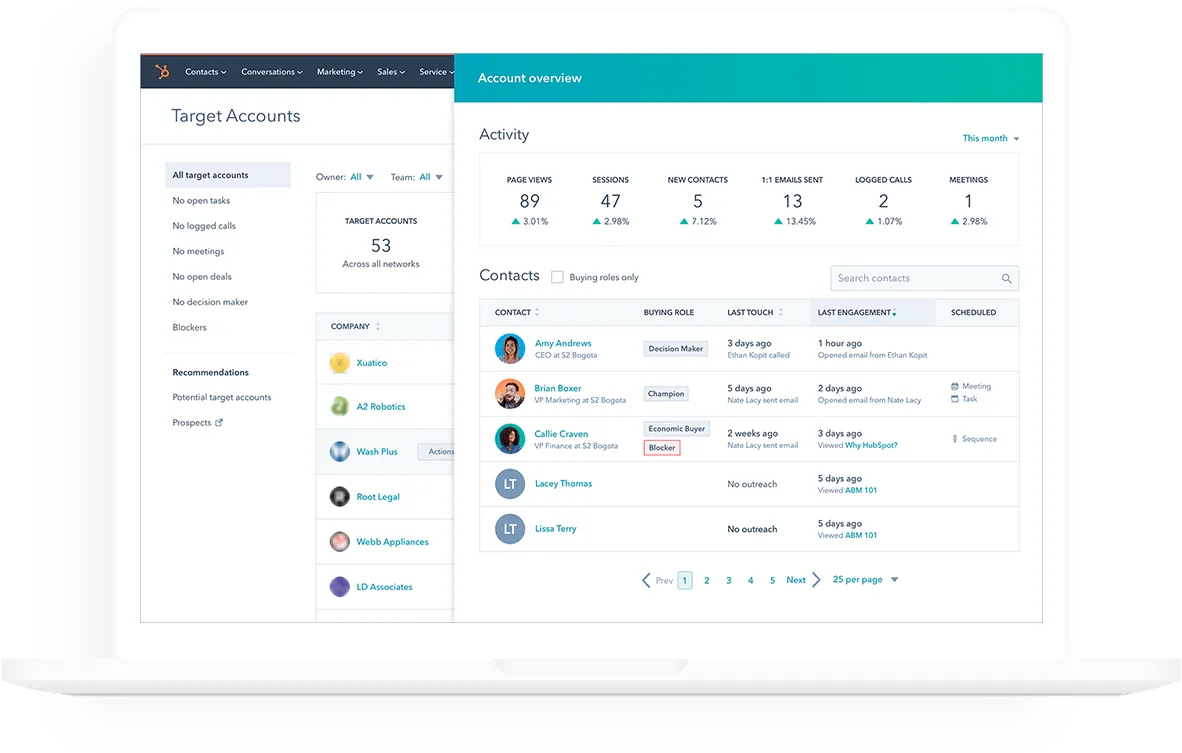
- Purpose: Integrates with your existing CRM to enhance lead management and streamline sales processes.
- Features: Email tracking, meeting scheduling, sales automation, and performance analytics.
- Benefits: Provides your sales team with tools to increase efficiency, allowing more time to focus on building relationships with existing customers and nurturing new leads.
4. BuzzSumo
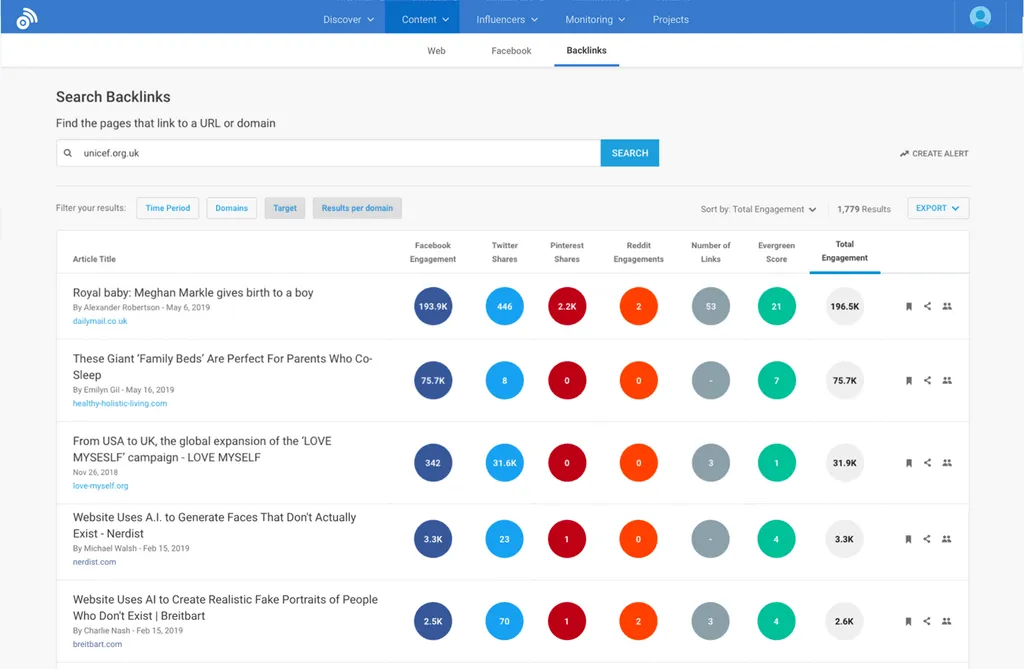
- Purpose: Focuses on content discovery and performance analysis to help you understand what content resonates best with your audience.
- Features: Content insights, influencer identification, and competitive research.
- Benefits: By understanding trending content and key influencers, you can align your content strategy with what works best on various social selling platforms.
5. Sprout Social
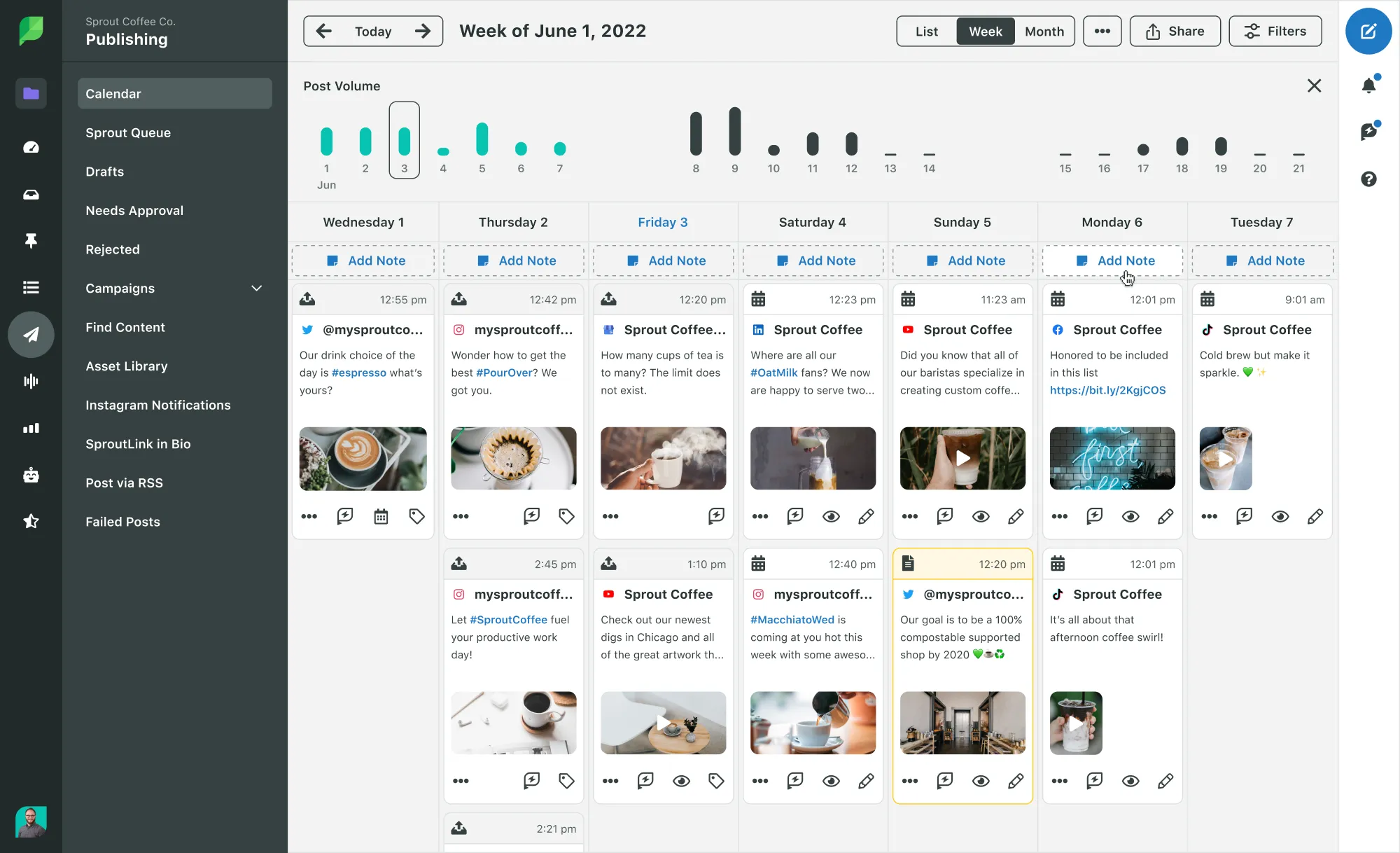
- Purpose: An all-in-one social media management tool that offers deep analytics and social listening capabilities.
- Features: Social CRM features, publishing, analytics, and engagement tools.
- Benefits: Sprout Social helps manage your social media efforts more effectively, from tracking engagement to analyzing the performance of your content, ensuring you adhere to social selling best practices.
6. Nimble

- Purpose: A simple, user-friendly CRM designed for high-efficiency networking on social media platforms.
- Features: Relationship management, social listening, and integration with major social networks.
- Benefits: Nimble automatically updates customer profiles with the latest social media activities and engagement, ideal for personal branding and keeping track of key contacts and conversations.
7. Zoho Social

- Purpose: Designed to help businesses grow their presence on social media with effective scheduling, monitoring, and analytics tools.
- Features: Real-time monitoring, collaborative publishing, and actionable insights.
- Benefits: Zoho Social is particularly effective for businesses looking to manage their social media outreach and engagement comprehensively, supporting social selling efforts with data-driven strategies.
8. Salesforce Social Studio

- Purpose: Part of the Salesforce Marketing Cloud, this tool helps manage your social media strategy and engagement from a sales perspective.
- Features: Social media publishing, customer service on social channels, and social media listening.
- Benefits: Salesforce Social Studio allows your sales team to engage with prospects and existing customers directly, integrating social interactions with Salesforce CRM for a seamless customer journey. It ensures your social media efforts are aligned with broader sales goals and best practices.
9. Oktopost
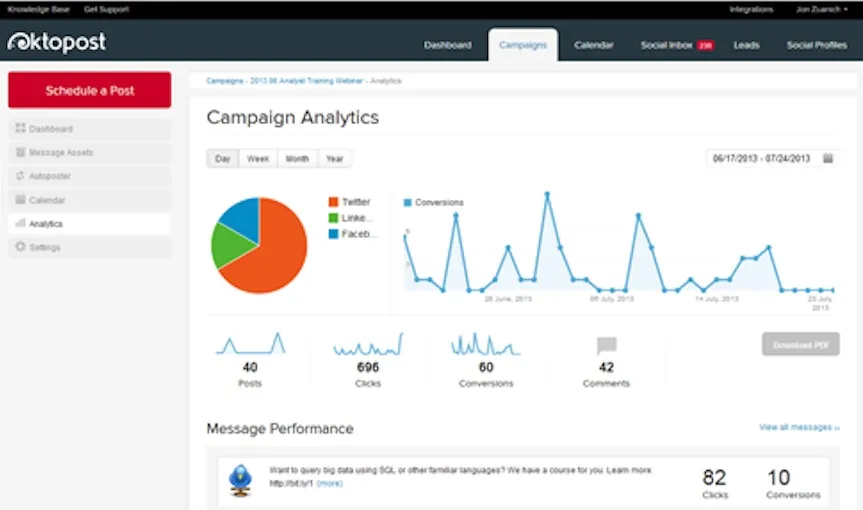
- Purpose: Designed specifically for B2B marketers, Oktopost focuses on content distribution and leads generation through social media.
- Features: Social media management, employee advocacy, and social selling.
- Benefits: It tracks the conversions generated from each post, making it an essential tool for B2B organizations looking to justify and measure the ROI of their social media efforts. Oktopost also enhances personal branding by enabling employee networks to amplify corporate content.
10. Leadfeeder

- Purpose: A tool that integrates with Google Analytics to help you identify which companies visit your website and how they engage with your content, even if they don't fill out a form.
- Features: Website visitor identification, CRM integration, and automation capabilities.
- Benefits: Leadfeeder helps bridge the gap between social selling and direct website engagement by providing insights into potential customers who are interested but haven't yet made contact. This tool is invaluable for understanding the effectiveness of your social media strategies and tailoring follow-up communications.
Analyzing Social Selling Efforts: Metrics and KPIs
Analyzing social selling efforts involves assessing how effectively your team uses social networks to close sales, establish rapport with prospects, and grow relationships that lead to sales.
By focusing on certain metrics and Key Performance Indicators (KPIs), businesses can measure the success of their social selling initiatives, make informed decisions, and refine their strategies. Here’s an in-depth look at relevant metrics and KPIs for social selling:
1. Social Engagement Metrics
Likes, Shares, Comments, and Mentions: These are basic indicators of how engaging your content is. High engagement rates often correlate with higher brand visibility and customer interaction.
Connection Growth: Tracks the increase in the number of connections or followers over time, showing how your network is expanding.
2. Content Performance Metrics
Content Reach: Measures the number of people who have seen your post since it was shared. This helps understand the extent of your content's visibility.
Click-through Rate (CTR): The percentage of people who clicked on a link within your post compared to the total viewers. High CTRs indicate effective content that drives interest.
Engagement Rate by Post: Assesses how much interaction each post receives relative to your number of followers. This can highlight what type of content resonates best with your audience.
3. Lead Generation Metrics
Lead Conversion Rate: Tracks how many leads generated from social channels have converted into customers. This is crucial for understanding the effectiveness of social selling in driving sales.
Inquiries or Direct Messages: The number of direct interactions with prospects can indicate the level of interest and potential for sales conversions.
4. Sales Metrics
Social Selling Index (SSI): LinkedIn offers a tool that measures your company's effectiveness at establishing a professional brand, finding the right people, engaging with insights, and building relationships on the platform.
Revenue Attribution: The percentage of total revenue that can be directly linked to social selling efforts. This KPI is vital for understanding the actual financial impact of your social media activities.
5. Customer Relationship Metrics
Customer Retention Rate: Measures how well your social selling strategies are keeping customers engaged and loyal over time.
Customer Satisfaction and Feedback: Monitoring feedback through social channels can provide insights into customer satisfaction and areas for improvement.
6. Employee Advocacy Metrics
Employee Engagement Rate: Tracks how actively your team members use social media for selling and engaging with content. High engagement suggests effective training and adoption of social selling practices.
Content Sharing by Employees: Measures how frequently your team shares company content on their networks. This can extend reach and enhance credibility.
Implementing and Tracking KPIs
To effectively track these metrics, companies should utilize social media monitoring tools and CRM systems that integrate social media data.
This allows for comprehensive analytics and helps correlate social selling activities with sales outcomes.
Strategic Adjustments Based on Analytics
The insights gained from these KPIs should guide strategic decisions such as:
- Refining content strategies based on what types of posts yield the highest engagement.
- Adjusting messaging to better resonate with target demographics.
- Identifying which social platforms are most effective for your brand
Concluding Thoughts
In conclusion, social selling is not just a trend but a crucial component of modern sales strategies. It empowers sales professionals to connect directly with prospects, leveraging the pervasive reach and interactivity of social media. The key to success in social selling lies in understanding and implementing a mix of strategies tailored to each platform, ensuring content resonates with the audience, and maintaining an active and engaging online presence.
By integrating these strategies with traditional sales methods and continually adapting to evolving digital landscapes, businesses can enhance their customer engagement, build stronger relationships, and ultimately drive significant sales growth. Implementing these approaches thoughtfully will position your brand at the forefront of your industry’s digital transformation.
Further Reading
Enhance your understanding of social selling and broaden your sales strategy toolkit with this thoughtfully curated selection of articles from Aloré's blog. These resources are designed to complement your social selling efforts, providing you with deeper insights into lead generation, email marketing, and more. Whether you're a seasoned sales professional or just starting out, these articles offer valuable insights for everyone:
- Social Media Lead Generation: Dive into effective strategies for generating leads on social media platforms, an essential skill for maximizing your social selling efforts. Explore Now.
- How to Market with Email: Learn how to seamlessly integrate email marketing with your social selling strategy to enhance your outreach and conversion rates. Learn More.
- Unlocking Success with Lead Generation: Discover outbound strategies that drive sales and complement your social selling techniques. Read Further.
- Lead Generation Strategies: Get insights into creating an effective lead generation process to consistently supply your sales funnel with high-quality leads. Dive Deeper.
- Creating Effective Lead Magnets: Find out how to design lead magnets that attract and convert your target audience on social media and beyond. Discover More.
These articles will equip you with additional tools and strategies to refine your approach and overcome any sales challenge with confidence.








